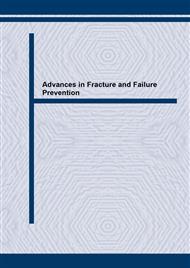[1]
Steam Generator Reference Book, Electric Power Research Institute, report TR103824, September, 1994.
Google Scholar
[2]
T. C. Lee, I. M. Robertson and H. K. Birnbaum, Metall. Trans. A, 21A (1990) p.2437.
Google Scholar
[3]
L. Priester, Mater. Sci. Engin. A 309-310 (2001) p.430.
Google Scholar
[4]
W. A. T. Clark, R. H. Wagoner and Z. Y. Shen T. C. Lee, I. M. Robertson and H. K. Birnbaum, Scripta Metall. et Mater. 26 (2) (1992) p.203.
Google Scholar
[5]
L. C. Lim and R. Raj, Acta Metall. 33 (8) (1985) p.1577.
Google Scholar
[6]
K. Onchi, N. Dohi, J.R. Soneda, R. J. Cowan, M.L. Scowen, and M.L. Castano, J. of Nucl. Mater., 320 (2003) p.194.
Google Scholar
[7]
N. Hashimoto, S.J. Zinkle, A.F. Rowcliffe, J.P. Robertson, and S. Jitsukawa, J. Nucl. Mater., 283-287 (2000) p.528.
Google Scholar
[8]
C. Bailat, A. Almazouzi, M. Baluc, R. Schaublin, R. Groschel, and M. Victoria, J. Nucl. Mater., 283-287 (2000), p.446.
Google Scholar
[9]
S. Bruemmer, J.I. Cole, J.L. Brimhall, R.D. Carter, and G.S. Was, in Proc. 6 th International Symposium On Environmental Degradation of Materials in Nuclear Power Systems – Water Reactors, San Diego, CA, The Metallurgical Society, Warrendale, PA, (1993), p.537.
Google Scholar
[10]
T.S. Byun, E.H. Lee, and J.D. Hunn, “J. Nucl. Mater., 321 (2003), p.29.
Google Scholar
[11]
E.S.P. Das and M.J. Marcinkowski, “J. Appl. Phys., 43, No. 11, (1972), p.4425.
Google Scholar
[12]
F. W. Crossman, M. F. Ashby, Acta Metall., 23 (1975) p.425.
Google Scholar
[13]
B. Alexandreanu and G. S. Was, Corrosion, 59 (2003) p.705.
Google Scholar
[14]
T. Watanabe, Metall. Trans. A, 14A (1983) p.531.
Google Scholar
[15]
H. Kokawa, T. Watanabe and S. Karashima, Phil. Mag. A, 44 (6) (1981) p.1239.
Google Scholar
[16]
R.C. Pond, D.A. Smith and P.W.J. Southerden, Phil. Mag. A, 37 (1978) p.27.
Google Scholar
[17]
F. Vaillant, J-D. Mithieux, O. de Bouvier, D. Vacon, G. Zacharie, Y. Brechet and F. Louchet, Proc. 9 th International Conference on Environmental Degradation of Materials in Nuclear Power Systems – Water Reactors, The Metallurgical Society, Warrendale, PA (1999), p.251.
DOI: 10.1002/9781118787618.ch26
Google Scholar
[18]
P. R. Swann, Corrosion,19,(1963) p. 102t.
Google Scholar
[19]
A. W. Thompson and I. M. Bernstein, “The Role of Metallurgical Variables in HydrogenAssisted Environmental Fracture,” in Advances in Corrosion Science and Technology, edited by R,W. Staehle and M. G. Fontana, Vol. 7, Plenum Press, New York, NY, (1980) p.53.
Google Scholar
[20]
C. G. Rhodes and A. W. Thompson, Met. Trans. A, 8A (1977) p.1901.
Google Scholar
[21]
R. E. Schramm and R. P. Reed, Met. Trans. A., 6A (1975) p.1345.
Google Scholar
[22]
R.E. Clausing and E.E. Bloom, in Grain Boundaries in Engineering Materials, eds. J.L. Walter, J.H. Westbrook, and D.A. Woodford, Claitors, Baton Rouge, LA, 1975. 23. J.T. Busby, Ph.D. Thesis, University of Michigan, 2001.
Google Scholar
[24]
R. B. Dropek, G. S. Was, J. Gan, J. I. Cole, T. R. Allen and E. A. Kenik, Proc.11 th Int’l Conf. Environmental Degradation of Materials in Nuclear Power Systems – Water Reactors, American Nuclear Society, La Grange Park, IL, in press.
Google Scholar
[25]
L.E. Murr, Metall. Trans. A,.6 (1975) p.505.
Google Scholar
[26]
S. M. Bruemmer and C. H. Henager, Jr., Proc. 2 nd International Symposium on Environmental Degradation of Materials in Nuclear Power Systems – Water Reactors,” American Nuclear Society, La Grange Park, IL, (1986) p.293.
Google Scholar
[27]
T.L. Gerber, Y.S. Garud, and S.R. Sharma, Thermal and Environmental Effects in Fatigue Research – Design Interface, PVP-vol. 71, C.E. Jaske, S.J. Hudak and M.E. Mayfield (Editors), ASME, 1983.
Google Scholar
[28]
Y.S. Garud and T.L. Gerber, “An Engineering Model for Predicting Stress Corrosion Cracking,” Advances in Life Prediction Methods, D.A. Woodford and J.R. Whitehead (Editors), ASME, 1983.
Google Scholar
[29]
J. M. Boursier, Desjardins, F. Vaillant, Corrosion Science, 37, No. 3 (1995) p.493.
Google Scholar
[30]
J. M. Boursier, O. de Bouvier, J. M. Gras, D. Noel, R. Rios and F. Vaillant, Proc. CorrosionDeformation Interactions, ed. T. Magnin and J. M. Gras, Les Editions de Physique, Cedex, France (1993) p.117.
Google Scholar
[31]
J.A. Begley, “Strain Rate Damage Model for Alloy 600 in Primary Water”, Westinghouse Electric Corporation, EPRI NP-7008, Project S303-8, October 1990.
Google Scholar
[32]
P. L. Andresen and F. P. Ford, Int. J. Pressure Vessel and Piping, 59 (1994) p.61.
Google Scholar
[33]
G. S. Was, Proc. 11th Int’l Conf. Environmental Degradation of Materials in Nuclear Power Systems – Water Reactors, American Nuclear Society, La Grange Park, IL, in press.
Google Scholar
[34]
P. M. Scott and M. Le Calvar, Proc. 6 th International Symposium on Environmental Degradation of Materials in Nuclear Power Systems – Water Reactors, The Metallurgical Society, Warrendale, PA (1993) p.657.
Google Scholar
[35]
G. S. Was, D. J. Paraventi and J. L. Hertzberg, Proc. Corrosion-Deformation Interaction, CDI’96, ed. T. Magnin, Institute of Metals, London (1997) p.410.
Google Scholar
[36]
D. Paraventi and G. S. Was, Corrosion 58 (8) (2002) p.687.
Google Scholar
[37]
J. L. Hertzberg, “ Ph.D. thesis, University of Michigan (1997) p.160.
Google Scholar


